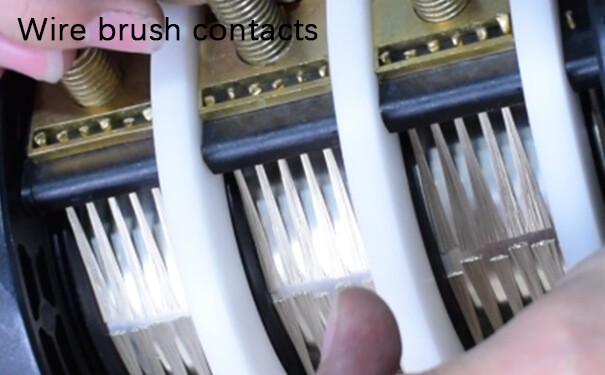Benefit from our deep dive into the world of wire brush slip rings. We provide detailed information on their operation, usage across industries, types available, installation, troubleshooting, safety precautions, and users’ FAQs.
Introduction to Wire Brush Slip Rings
Wire brush slip rings, colloquially known as rotary electrical joints, are sophisticated electromagnetic devices designed to transmit electrical power and signals from a stationary structure to a rotating one. These components play a critical role in ensuring an uninterrupted energy flow within various machinery where traditional cabling and connector systems may fail due to rotary motion.
Picture a cylindrical device having a central shaft around which several concentric rings are arranged. These rings are insulated from each other, and each carries a distinct electrical signal or power. Small wire brush-like structures make contact with these rotating rings. As names suggest, these wire brushes slide or ‘slip’ over the rotating rings, hence the name ‘slip rings.’
In essence, each wire brush connects to a stationary component and slides over the corresponding ring as it rotates, thereby creating a connection that effectively transmits the electrical signals or power. This relative motion between brushes and rings enables the device to maintain a continuous electrical connection, despite the rotational movement.
It is this design and unique functioning principle that underlies their use in diverse applications such as wind turbines where the blades rotate continuously, radar antennas, and carnival rides, where rides often rotate and tilt simultaneously.
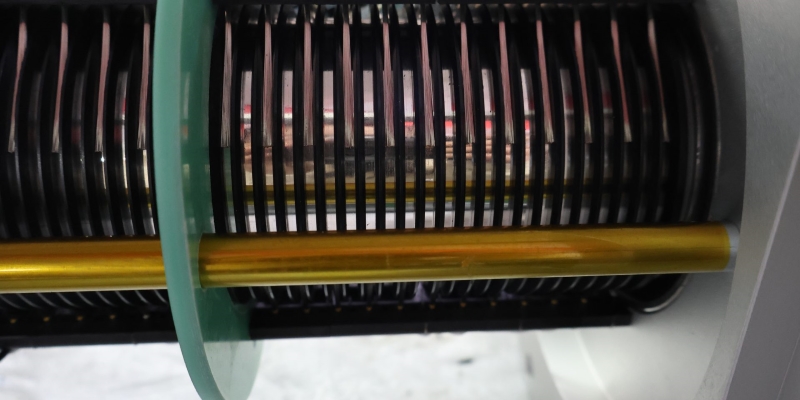
Usage and Importance of Wire Brush Slip Rings
Wire brush slip rings are employed across numerous industries due to their unique mechanism that enables efficient data and power transmissions between stationary and rotational areas of a machine. Traditional methods of transmitting signals, such as standard cables, often become impractical or impossible in machinery involving consistent rotation. This is because of the tangling and damage that can result from twisting cables. Here, wire brush slip rings fill the gap, offering a seamless, uninterrupted flow of electrical signals.
In addition to uninterrupted signal transmission, these devices greatly reduce wear and tear caused by consistent mechanical rotation. This plays a significant role in lowering maintenance costs and efforts while improving overall machine longevity.
In the industrial sphere, wire brush slip rings are convincingly used in wind turbines. These turbines require a constant transmission of power and data between the stationary nacelle and the rotating blades. These slip rings are a cornerstone to their seamless operation, facilitating power and data flow.
Wire brush slip rings are also integrated into radar antennas, where they enable the antenna to rotate 360 degrees continuously while sending and receiving signals without interruption. Furthermore, in the field of entertainment and amusement, wire brush slip rings are a fundamental part of rides that involve simultaneous rotation and tilting.
The medical sector greatly benefits from these slip rings, too, particularly in the realm of computerized tomography (CT) scan machines. As the scanning frame rotates around the patient, the slip ring enables the transfer of real-time imaging data to the stationary computer.
In essence, wire brush slip rings’ flexibility, efficiency, and ability to reduce mechanical wear have entrenched their importance across diverse industries, playing a pivotal role in the smooth operation of many rotary machines.
Types of Wire Brush Slip Rings
Given the extensive range of industrial needs, there is a wide variety of wire brush slip rings available. Each type is designed to address a specific set of requirements, allowing diverse sectors to benefit from this refined technology.
Electrical Slip Rings
Also known as rotary electrical interfaces, rotating electrical connectors, collectors, swivels, or electrical rotary joints, these are the most common types of slip rings. They transmit electric power and electrical signals between a stationary and a rotating structure. These devices are often used in systems that require rotation while transmitting power or signals, like wind turbines or radar antennae.
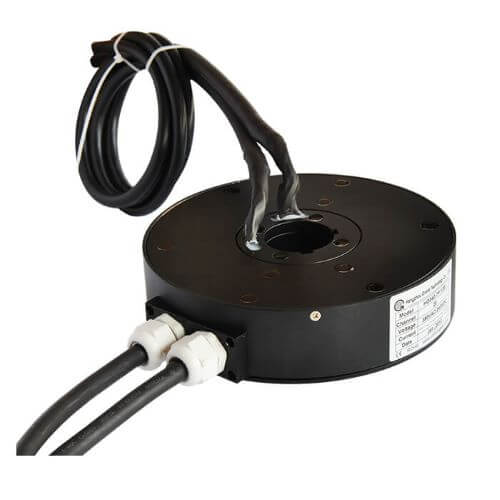
Fiber Optic Rotary Joints (FORJs)
These sophisticated slip rings are utilized for transmitting optical signals across a rotating interface. Employing advanced materials and designs, they offer several channels for signal transmission. They are widely used in high-speed data systems like satellite communication and high-definition video broadcasting.
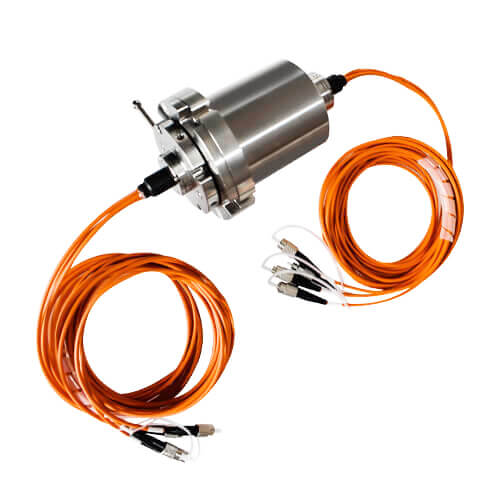
Pneumatic or Hydraulic Rotary Unions
These slip rings transfer fluids or gases from a stationary structure to a rotating one, or vice versa. They are widely used in industries such as food processing, chemical, and heavy machinery, where fluid or gas flow control in rotating equipment is necessary.
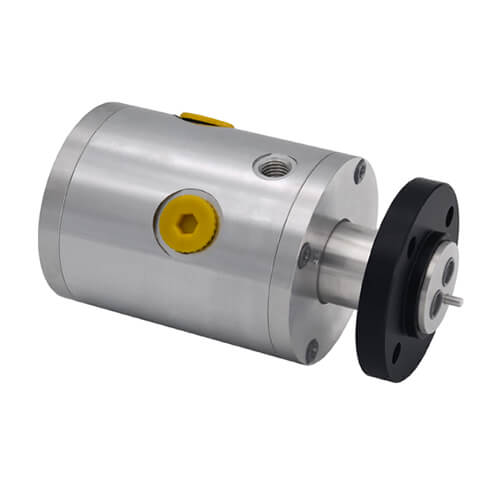
Pancake Slip Rings
Named after their unique flat structure, pancake slip rings are specifically designed for systems with height restrictions. They are generally used in applications where length is not restricted but height is, like in CCTV systems and compact rotation systems.

Capsule Slip Rings
Compact and cost-effective, Capsule slip rings are used in equipment that requires the transmission of power and signal but have restricted space for full-sized conventional slip rings. CCTV cameras and robotic arms are some examples where capsule slip rings are commonly used.
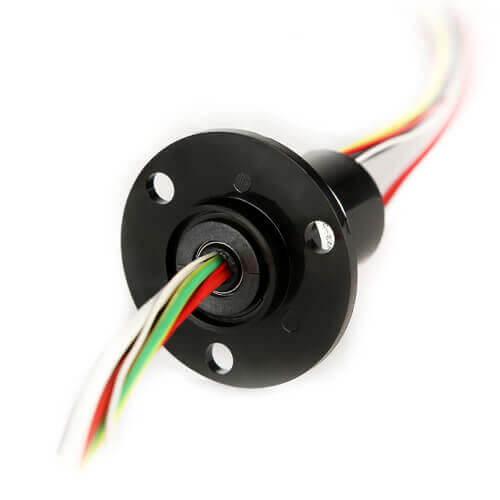
Each type of wire brush slip ring has been ingeniously engineered to aptly meet the specific demands of different applications. The diverse types cater to a vast array of industries, optimizing machine performance and effectively addressing the challenges of power and signal transmission.
How Wire Brush Slip Rings Function
Wire brush slip rings function using an intricate mechanism that maintains electrical contact between a stationary structure and a rotating one. These devices are designed to tackle the challenges of continuous rotation present in various types of machinery and systems.
Operational Principles
The primary components of a wire brush slip ring include concentric metallic rings mounted on a central rotating shaft and wire brushes that glide over the individual rings. Each metallic ring remains electrically isolated from the others. Each wire brush, connected to a separate stationary component, maintains contact with its corresponding ring as it revolves around the shaft.
As the brushes slip over the rings, the electrical connection is maintained, allowing the wire brush slip ring device to transfer power and signals between the static part (brushes) and the rotating part (rings) of the equipment.
To prevent undue friction between the brushes and the rings, materials like copper, brass, and silver are commonly used due to their high conductivity and low friction coefficients.
Signal and Data Transmission
In applications where signals or data must be transmitted through wire brush slip rings, several rings are often designated as signal rings and power rings, respectively. Each signal or data channel can be allocated a separate ring to enable the smooth transmission of multiple data inputs.
As the rings rotate, they maintain electrical contact with the corresponding brushes, which are connected to the stationary components transmitting the data. This electrical connection and the relative motion between brushes and rings enable data to be transmitted across the rotating stationary interface.
Illustration
To help visualize the working principle of a wire brush slip ring, imagine a record player. The grooves on a vinyl record can represent the rotating metallic rings, while the record player’s needle represents the wire brushes. As the vinyl record rotates, the needle maintains its position in the groove, allowing the music to be played continuously. This analogy closely mimics the way wire brush slip rings maintain electrical contact during rotation.
In summary, wire brush slip rings function by utilizing a well-designed system of wire brushes and metallic rings to facilitate the uninterrupted transmission of signals and power while enabling continuous rotation. This unique mechanism is invaluable in a wide array of applications, improving operational efficiency and reducing wear and tear.
Wire Brush Slip Rings: Materials Used, Quality, and Durability
Selecting the appropriate materials for a wire brush slip ring is vital to its overall performance, durability, and reliability. Factors such as electrical conductivity, hardness, and wear resistance are essential considerations in the choice of materials. In addition, compatibility with different environments (e.g., temperature, humidity, and corrosiveness) can also impact the selection process.
Common Materials
- Rings and Brushes: The principal materials used to manufacture the rings and wirebrushes in slip rings are metals with high electrical conductivity and low friction. Copper, brass, gold, silver, and various alloys are among the most common choices. These metals offer a balance between efficiency and wear resistance, ensuring smooth operation and long service life.
- Copper: Copper is an excellent conductor of electricity, and due to its malleability, it is often used to create wire brushes. Copper rings and brushes can deform and adapt to slight variations in the contact surface, reducing friction and wear.
- Brass: Brass, an alloy of copper and zinc, is often used for slip ring rings due to its durability and good electrical conductivity.
- Gold and silver: Gold and silver-based alloys are often used in high-performance slip rings that demand long life, low electrical noise, and excellent signal transmission. Their low contact resistance and long-lasting wear characteristics come at a higher cost but offer superior performance in mission-critical or high-spec applications.
- Insulation Materials: Insulating materials are used to electrically separate the concentric rings in a slip ring assembly. These materials must have high dielectric strength, good mechanical properties, and withstand changes in temperature and humidity. Commonly used materials for insulation include various engineering plastics, epoxy resins, and ceramics.
Impact on Quality, Durability, and Longevity
High-quality materials, such as precious metals and robust insulation materials, contribute significantly to the longevity and lasting performance of wire brush slip rings. The use of high-conductivity metals reduces electrical losses and subsequently generates less heat, which extends the slip ring’s operational life.
Quality materials also contribute to the stability and reliability of signal and power transmission, ensuring consistent performance and reducing downtime due to maintenance or unexpected failure.
Furthermore, choosing materials that are suited to the specific environmental conditions of each application is crucial for maximizing service life and performance. For instance, corrosion-resistant metals or coatings can provide the necessary durability in humid or corrosive environments.
In conclusion, the materials used in the manufacture of wire brush slip rings play a vital role in determining their quality and durability. The proper selection of materials, taking into account various factors such as electrical conductivity, hardness, and environmental conditions, can greatly enhance the longevity and performance of these critical components.
Installation and Maintenance of Wire Brush Slip Rings
A thorough understanding of the wire brush slip ring installation process is crucial for their optimal operation, longevity, and efficiency. Moreover, consistent and appropriate maintenance methods can help ensure that these devices work effectively for extended periods, contributing to smoother functions and minimized downtime in various industries.
Installation of Wire Brush Slip Rings
The installation process for wire brush slip rings varies across types and designs, but the following general steps provide an overview:
- Identification and Preparation: Start with identifying the correct placement for the slip ring. Prepare the area, ensuring it’s clean and free of dust or debris.
- Aligning the Slip Ring: Position the slip ring to align with the mounting holes or structure of the rotating device where it is to be installed.
- Mounting the Slip Ring: Securely mount the slip ring either by the flange or directly onto the shaft, depending on the design of the slip ring.
- Connect the Exits: Connect the stationary and rotating wires or cables from the slip ring to the corresponding parts of your equipment.
- Testing: Finally, conduct a series of tests to confirm the slip ring’s operational performance and correct functioning.
Always refer to the manufacturer’s manual for specific installation guidelines, as certain slip ring models may require unique handling or additional assembly steps.
Maintenance of Wire Brush Slip Rings
Regular maintenance is imperative to uphold the functionality of wire brush slip rings, ensuring consistent operation and reduced chances of sudden breakdowns.
Maintenance generally includes the following steps:
- Observation: Regularly observe the slip ring and its functioning. Look for any visible signs of wear, such as brush wear or unusual noises.
- Brush Inspection: Inspect the wire brushes for wear and tear periodically. Consider replacing the brushes before they’re completely worn down to prevent damage to the rings.
- Cleaning: Clean the slip rings periodically to remove any debris accumulation.
- Electrical Tests: Conduct routine electrical tests to ensure the slip rings maintain sound electrical properties.
- Lubrication: Depending on the model and required conditions, certain slip rings might require periodic lubrication to maintain low friction and efficient operation.
By following these steps, the longevity, reliability, and efficiency of the wire brush slip rings can be significantly improved. Regular and proactive maintenance can result in fewer interruptions due to unexpected failures or outages, contributing to improved operational efficiency overall.
These procedures highlight the importance of proper installation and maintenance in preserving the performance and durability of wire brush slip rings, thereby playing an integral role in smooth industrial operations powered by these innovative devices.
Common Problems and Troubleshooting with Wire Brush Slip Rings
Like any mechanical or electrical component, wire brush slip rings can face issues during their operation. Identifying these problems and resolving them is essential to ensuring the performance and longevity of these devices. Furthermore, employing preventative measures can help maintain the efficiency of wire brush slip rings while minimizing the chances of failure.
Common Problems
- Electrical Noise: Excessive electrical noise or interference can cause unreliable signal transmission, especially in applications that require precise data transfer.
- Brushes and Ring Wear: Over time, brushes and rings can experience wear and tear due to friction during continuous rotation. This can lead to reduced operational efficiency or even failure.
- Corrosion or Contamination: Slip rings can suffer from corrosion or contamination due to exposure to harsh environments or debris, which affects their performance and lifespan.
- Poor Electrical Contacts: Inefficient electrical contact between the brushes and rings may result in intermittent power or signal transmission.
- Temperature Issues: Excessive operating temperatures can cause damage to slip rings or interfere with their performance, leading to failures or inefficiencies.
Troubleshooting Tips
- Electrical Noise: To resolve electrical noise issues, ensure that shielding on signal cables is intact and properly connected. Additionally, consider using slip rings with precious metals (silver or gold alloys) to minimize electrical noise and maintain good signal transmission.
- Brushes and Ring Wear: Inspect brushes and rings regularly for signs of wear. Proactively replace brushes before they are completely worn out to prevent damage to rings. Frequent cleaning of slip rings can help reduce the effects of abrasion.
- Corrosion or Contamination: Check for corroded rings or brushes, and replace the damaged components if necessary. Ensure that the slip ring is protected and cleaned periodically, especially if it operates in a corrosive or dusty environment.
- Poor Electrical Contacts: Examine the wire brushes and rings for proper contact. Adjust the brush tension or alignment, or clean the contact surfaces if needed, to improve the electrical connection.
- Temperature Issues: Monitor the slip ring’s operating temperature. Provide adequate cooling mechanisms, such as heat sinks or fans, if necessary to maintain temperatures within safe operating limits.
Preventative Measures and Efficiency Maintenance
- Regular Inspections: Routinely inspect the wire brush slip rings for signs of wear, corrosion, or contamination. Taking immediate action before issues escalate can prevent breakdowns and maintain performance.
- Cleanliness: Keep the work environment and slip rings clean to minimize the accumulation of debris or contaminants that can affect the slip ring performance.
- Lubrication: For certain models, periodic lubrication might be essential to maintain low friction and efficient operation.
- Operational Conditions: Ensure the slip ring is operating within the manufacturer’s recommended environmental and electrical parameters.
Following these guidelines and troubleshooting tips can help identify and rectify common problems in wire brush slip rings, ensuring the reliability and efficiency of these devices. In addition, taking preventative measures can extend their lifespan and maintain their operational performance, contributing to the overall success of the systems that rely on them.
Safety Precautions for Wire Brush Slip Rings
Handling wire brush slip rings, like any piece of electrical or mechanical equipment, necessitates the observance of specific safety precautions to protect both the user and the integrity of the system. These precautions are applicable during the installation, operation, and maintenance of wire brush slip rings.
Installation Safety Precautions
- Disconnect Power: Always ensure that the power is turned off before starting any installation activities. This helps prevent any accidental exposure to live electrical parts that could result in electric shocks.
- Use Proper Tools: Use the right tools and equipment for the job. This not only ensures that the installation process proceeds correctly but also minimizes the risk of accidental injury.
- Follow Manufacturer Instructions: Always refer to the manufacturer’s instructions for specific installation guidelines. These instructions typically include the recommended process, potential hazards, and ways to mitigate them.
Usage Safety Precautions
- Operating Conditions: Be sure to operate the slip ring within the manufacturer’s recommended environmental and electrical parameters. Overloading or incorrect usage can lead to equipment failure, electrical hazards, or even fires.
- Handle with Care: Handle the slip ring gently to prevent any physical damage. Sudden shocks or forces can lead to component failure or shorten the lifespan of the slip ring.
- Routine Inspections: Regularly inspect the wire brush slip rings for any signs of wear, overheating, or electrical malfunctions that may pose a safety risk.
Maintenance Safety Precautions
- Power Off: As with installation, always disconnect the power during any maintenance activities to prevent accidental electric shocks or contact with live electrical parts.
- Use Personal Protective Equipment (PPE): Depending on the environment and required tasks, workers may need to use appropriate PPE such as safety goggles, gloves, and appropriate clothing to prevent any injury.
- Follow Cleaning Protocols: While cleaning slip rings, use only recommended cleaning solvents or materials to avoid any adverse reactions that could pose a safety hazard or damage the slip ring.
By adhering to these guidelines during the installation, operation, and maintenance of wire brush slip rings, users can significantly lower the risk of accidents or damage, ensuring both personnel safety and the continued reliability of the device. It is essential to understand and respect the inherent risks in dealing with electrical components and applying due diligence at all times.
Conclusion
With the rising demands of various industries, the importance of wire brush slip rings becomes even more apparent. As we continue to push technological boundaries, wire brush slip rings, with their unique ability, remain a crucial part of the journey, catering to a wide array of applications.
FAQs about Wire Brush Slip Rings
Wire brush slip rings hold a central role in maintaining continuous power or signal transmission in rotary systems. While they are a crucial component, users often have queries and concerns about their functionality, operation, and maintenance. The following FAQs aim to address these common concerns:
Q1: What are wire brush slip rings?
A: Wire brush slip rings are an electrical rotary joint that enables the transfer of electrical power or signals from a stationary part to a rotating part in a system. The wire brushes serve as the key component that ensures contact between the stationary and rotating parts.
Q2: How often should I replace the brushes in a wire brush slip ring?
A: The replacement frequency of brushes largely depends on the operating conditions and usage of the slip ring. However, in general, it is a good practice to replace the brushes whenever they wear down to approximately 50% of their original length.
Q3: Can I use a slip ring in extreme temperatures?
A: While most slip rings can operate within a wide temperature range, extreme temperatures can impact their performance and lifespan. Always refer to the manufacturer’s specifications for the recommended operating temperature range.
Q4: Why am I experiencing excessive electrical noise in my slip ring system?
A: Excessive electrical noise could be a result of several issues such as poor shielding on signal cables, inadequate grounding, or suboptimal contact between the brush and the ring. To reduce electrical noise, ensure proper cable shielding, adequate grounding, and optimal brush-ring contact.
Q5: How can I extend the lifespan of my wire brush slip ring?
A: Proper installation, regular checks, and appropriate maintenance of wire brush slip rings can significantly extend their lifespan. This includes the regular replacement of worn-out brushes, cleaning to remove debris, periodic electrical testing, and operating the slip ring within the manufacturer’s specified conditions.
See What We Can Do

